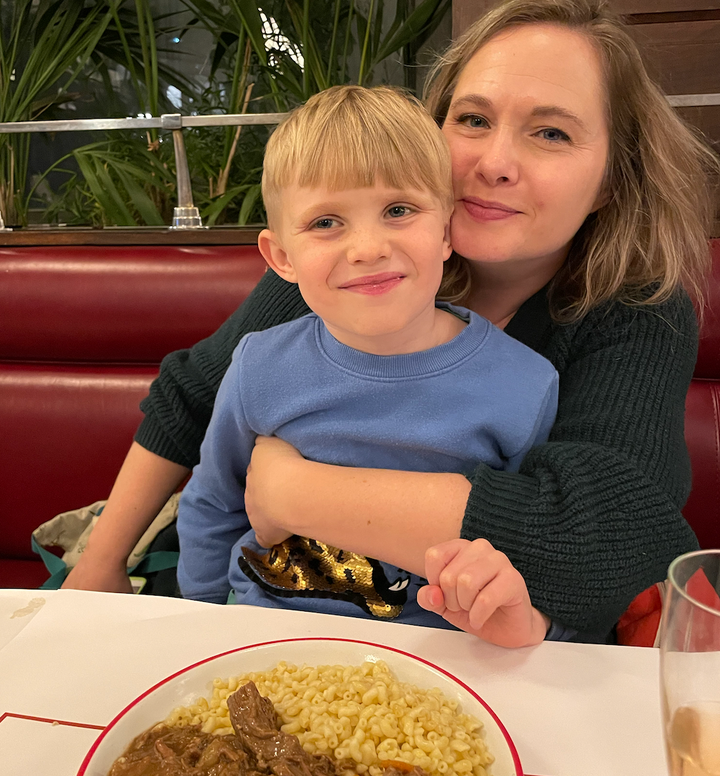
On the edge of a bustling square in Bordeaux, France, there’s a small menu posted on the outside of an ancient limestone building, just beside its massive blue doors. The menu changes weekly, drawing passersby who review it with interest. For each day of the week (except Wednesday), there’s a different four-course meal on offer including a starter, main, cheese course and dessert. This isn’t the menu du jour of another trendy restaurant in a neighbourhood that’s overflowing with them — it’s my son’s school lunch menu.
As an American who recently moved to Bordeaux with my family, culture shocks have become a familiar part of my daily life. Everything from grocery shopping and socialising to health care is dramatically different here in France, but somehow Oliver’s school lunch seems like one of the most significant differences between our old life and our new one.
The cantine at the school is a cozy yellow room where the students sit at tables with eight place settings. The meal is served on real plates with real cutlery, which are washed and reused the following day. A pitcher of water sits on each table, which students pour into their own glasses and refill themselves when more is needed.
“You might assume this is all some fancy private school frivolity, but you’d be wrong. Lunches like this are pretty standard fare in both public and private schools across France.”
The meal is prepared by a catering company off-site in the morning at the main school complex and transported to the school each day. Local, seasonal ingredients are prioritised, including sustainable seafood and organic produce. The meal is served in courses, with a starter, a main course, a dairy course (yogurt or cheese), and dessert.
A recent Friday lunch was salade de lentilles (lentil salad), aiguillettes de saumon meuniere (butter-fried salmon) with ratatouille, emmental for the cheese course, and organic fruit salad for dessert. Other days featured tajine with olives, vegetarian Cantonese rice and homemade peach milk cake.
Students are asked whether they want a full portion or a small amount to taste first, but they’re encouraged to at least try everything offered. If they want more, they can ask for another serving. Lunch lasts about 40 minutes, after which the students clear the tables themselves, scraping any uneaten food into a bowl to be composted. They spend the rest of their break on the playground.

You might assume this is all some fancy private school frivolity, but you’d be wrong. Lunches like this are pretty standard fare in both public and private schools across France. As for the cost, that varies depending on the region, and sometimes based on family income, but it’s typically similar to school lunch prices in the U.S.
Compared to a standard American school lunch, the French experience may sound like a fantasy — or insufferably fussy, depending on your perspective. Do kids really need a multi-course meal prepared with high-quality ingredients? What’s the point of it all, and what does any of this have to do with education?
And that, mes amis, is why something as simple as a school lunch turned out to be such a massive culture shock for me and my family. I realsed that in France, lunch isn’t just an obligatory break during which students are stuffed full of beige foods before being sent to their next class. Lunch is very much a part of the students’ education where they learn about proper nutrition, balanced eating and the value of trying new things. They’re practicing socialising, self-sufficiency and sustainability while benefiting from a well-deserved rest in the middle of a busy day.
It’s clear that these lunchtime lessons stick with the French into adulthood. Across France, lunch is viewed as a sacred time in the middle of the day to decompress and nourish the body, often while reconnecting with friends and family. Some stores close midday so the shopkeepers can go home for a break. People gather on café terraces and at restaurants for a long, leisurely meal, often with a glass of wine during and a coffee at the end. On sunny days, the parks are filled with families, groups of friends and co-workers sharing lovingly prepared picnics. It’s still very rare to see someone eating lunch on the go or at their office desk.
In France, food isn’t just fuel — it’s a crucial element of the French way of life. I’m so grateful that my son has had this experience during our time in France, and when we return to the States, we’ll be taking some of these new habits with us. He may not have a 1 1/2-hour lunch break or a four-course meal at school, but we can slow down and savour our meals together while challenging ourselves to keep pushing beyond our comfort zones — no matter where we are. And I might just slip some stinky cheese in his lunchbox, for old time’s sake.